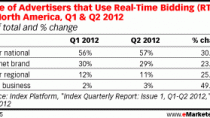Amobee、digital-out-of-home (DOOH)領域に進出か
SINGAPORE–Amobee is expanding into digital-out-of-home (DOOH) advertising in Asia where it sees opportunities from the region’s strong mobile penetration and high retail spending in Asia.
According to Trevor Healy, CEO of Amobee, there is a huge potential for bringing the mobile experience across different screens in the region especially in DOOH where multiple digital screens in public places, are used to push advertisements.
Other than the strong growth on mobile devices in the region, retail and consumer spending is also the highest in the world, Healy noted. This is coupled with the rise of the middle class and disposable income in Asia, he added, in an interview here Wednesday.
Leveraging mobile
For example, within a department store, consumers can use a public screen to navigate and explore the various sections, and subsequently use the navigation system on their mobile devices, while user data can also be harvested and presented to business owners based on when the user clicks on, the CEO pointed out.
Through digital displays in malls, marketers can also offer shoppers a gamified brand experience, where the user can flick a screen to kick a ball, spin a roulette wheel, or play a motion sensor based game using the built-in camera of the display.
Other technologies can also be used to make the shopping experience more interactive such as near field communications (NFC), QR codes and gesture technology, he added.
Amobee is also in a “unique” position for in the DOOH market because of its experience with mobile advertising , Healy explained. Having been acquired by SingTel which is one of the largest telcos in the region, the company also understands Asia-Pacific consumers well, he added.
This is not the company’s first entry into the DOOH market though, as it had “experimenting” in the market in America, Europe and Australia for almost a year now, Healy pointed out, adding the company had rolled out campaigns offering free Wi-Fi via kiosks at bus stops in New York City, U.S and river taxis in Sydney, Australia.
However, these initiatives had mostly been campaign-driven and Amobee hopes to bring the experiences of running campaigns through DOOH advertising to Asia, he added.
Healy also does not expect a single campaign to be run across the entire region because it has many different socioeconomic groups and cultures, which is “something Amobee respects”.
Moving forward, the company plans to do more DOOH advertising in China as many companies in the West are hoping to advertise and market their products and services in the region, Healy noted.
He also acknowledged the move was not without its challenges because it will face regulatory hurdles, language barriers and inventory sources being very different.
That said, Amobee will continue its push into China where retail spending, especially online shopping is the highest in the world, Healy said.












